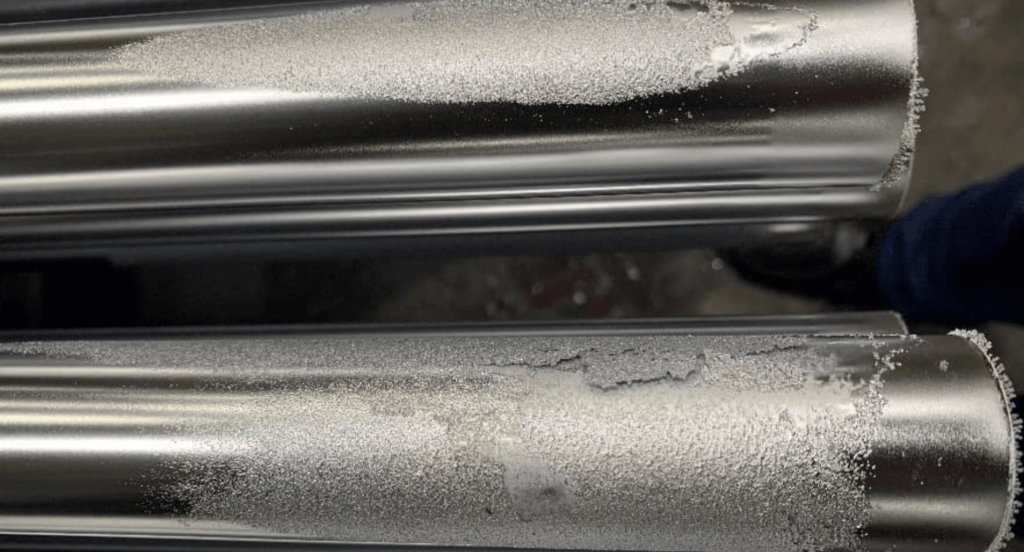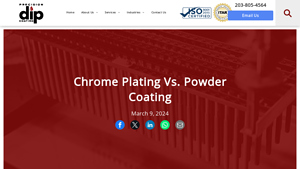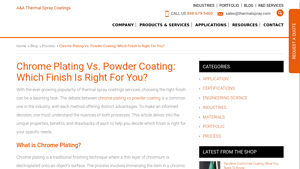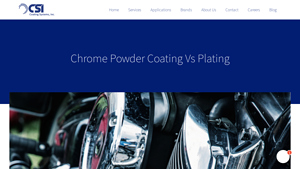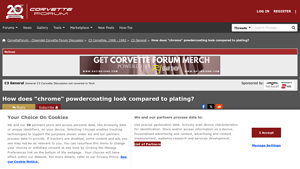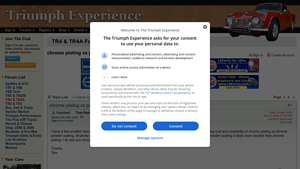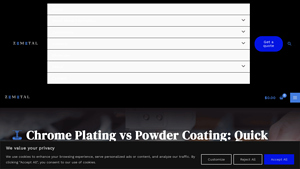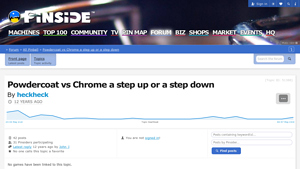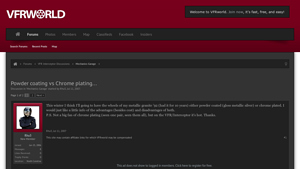Chrome Powder Coating Vs Chrome Plating Guide: Type, Cost, Top List…
Introduction: Navigating the Global Market for chrome powder coating vs chrome plating
In the dynamic landscape of global manufacturing, the decision between chrome powder coating and chrome plating poses a significant challenge for B2B buyers. Understanding the nuances of these finishing processes is crucial for those sourcing solutions that balance aesthetics, durability, and environmental impact. This guide delves deep into the intricacies of chrome powder coating and chrome plating, exploring their unique properties, applications, and suitability for various industries.
We will provide insights into the different types of finishes available, the specific applications that benefit from each process, and guidance on how to effectively vet suppliers to ensure quality and compliance with international standards. Additionally, we will analyze cost considerations and long-term value, helping you make informed decisions that align with your operational goals and budget constraints.
This comprehensive resource is designed to empower international B2B buyers, particularly those from Africa, South America, the Middle East, and Europe, including emerging markets like Vietnam and Brazil. By equipping you with the knowledge needed to navigate the complexities of chrome finishes, we aim to facilitate smart purchasing decisions that enhance your product offerings and drive business success. Whether you are in the automotive, aerospace, or decorative sectors, understanding the strengths and limitations of chrome powder coating versus chrome plating is essential for achieving optimal results.
Understanding chrome powder coating vs chrome plating Types and Variations
| Type Name | Key Distinguishing Features | Primary B2B Applications | Brief Pros & Cons for Buyers |
|---|---|---|---|
| Chrome Plating | Electroplated chromium layer, shiny finish | Automotive parts, decorative fixtures | Pros: Excellent corrosion resistance, aesthetic appeal. Cons: Toxic chemicals, potential for chipping. |
| Hard Chrome Plating | Thicker chromium layer for wear resistance | Industrial machinery, hydraulic rods | Pros: Exceptional durability, good for high-friction applications. Cons: Higher cost, limited aesthetic options. |
| Chrome Powder Coating | Dry powder application, eco-friendly, available in various colors | Consumer goods, automotive parts | Pros: Wide range of colors, less environmental impact. Cons: Less reflective finish, initial setup cost. |
| Decorative Chrome Coating | Aesthetic-focused plating with a thin layer of chrome | Luxury items, home decor | Pros: Attractive finish, enhances product value. Cons: Less durable, susceptible to scratches. |
| Electroless Nickel Plating | Nickel-based coating providing corrosion resistance | Electronics, automotive components | Pros: Uniform thickness, excellent corrosion resistance. Cons: Higher initial investment, less shiny finish. |
What Are the Key Characteristics of Chrome Plating?
Chrome plating involves electroplating a thin layer of chromium onto a metal surface, resulting in a highly reflective finish. This method is widely used in the automotive industry for parts like bumpers and wheels, as well as in decorative fixtures. While it offers excellent corrosion resistance and a striking aesthetic, buyers must consider the environmental impact due to the toxic chemicals involved in the process.
How Does Hard Chrome Plating Differ from Standard Chrome Plating?
Hard chrome plating is characterized by a thicker layer of chromium, designed specifically for applications requiring enhanced wear resistance. Industries such as manufacturing and construction utilize this type for components like hydraulic rods and machinery parts. Although it provides exceptional durability, the higher costs and limited aesthetic appeal may deter some buyers, especially those focused on decorative applications.
What Benefits Does Chrome Powder Coating Offer for B2B Buyers?
Chrome powder coating utilizes a dry powder that is applied electrostatically and cured in an oven. This method is favored for its eco-friendly properties, producing minimal volatile organic compounds (VOCs) while allowing for a variety of colors and textures. Common applications include consumer goods and automotive parts. However, while it offers robust durability against scratches and UV rays, it lacks the mirror-like finish of traditional chrome plating, which may be a deciding factor for buyers prioritizing aesthetics.
Why Choose Decorative Chrome Coating for Luxury Products?
Decorative chrome coating involves applying a thin layer of chrome primarily for aesthetic purposes. It is commonly used for luxury items and home decor, enhancing visual appeal and perceived value. However, this type of coating is less durable than hard chrome or powder coating and may be prone to scratches. Buyers should consider their target market and product lifespan when selecting this option.
What Are the Advantages of Electroless Nickel Plating?
Electroless nickel plating is a process that deposits nickel uniformly across a surface without the need for electrical current. This method is particularly beneficial in industries like electronics and automotive, where uniform thickness and excellent corrosion resistance are critical. While it may require a higher initial investment and does not provide the same shiny finish as chrome plating, its durability and protective qualities make it a valuable choice for many B2B applications.
Key Industrial Applications of chrome powder coating vs chrome plating
| Industry/Sector | Specific Application of chrome powder coating vs chrome plating | Value/Benefit for the Business | Key Sourcing Considerations for this Application |
|---|---|---|---|
| Automotive | Chrome plating for car bumpers and trims | Enhances aesthetic appeal and corrosion resistance | Regulatory compliance, environmental impact, and cost-effectiveness |
| Electronics | Chrome powder coating for electronic housings | Provides durability and heat resistance | Compatibility with materials, thermal management, and finish quality |
| Construction | Chrome plating for architectural fixtures | Offers a high-gloss finish and weather resistance | Long-term durability, aesthetic preferences, and maintenance needs |
| Machinery Manufacturing | Chrome powder coating for machine parts | Increases wear resistance and prolongs equipment life | Application method, surface preparation, and adhesion properties |
| Furniture | Chrome plating for decorative furniture elements | Elevates design and protects against corrosion | Design flexibility, surface finish requirements, and environmental standards |
How is Chrome Plating Used in the Automotive Industry?
Chrome plating is widely utilized in the automotive sector, particularly for car bumpers, grills, and trim pieces. The process enhances the visual appeal of vehicles while providing robust corrosion resistance, which is crucial for maintaining the aesthetic over time. For international buyers, particularly in regions like Africa and South America, understanding local regulations on chemical usage and environmental compliance is essential, as chrome plating involves hazardous materials. Businesses must also consider the cost of maintenance and potential rework due to wear over time.
What are the Benefits of Chrome Powder Coating in Electronics?
In the electronics sector, chrome powder coating is increasingly favored for electronic housings and components. This method offers superior durability and heat resistance, making it ideal for devices that generate significant heat. For B2B buyers in regions such as the Middle East and Europe, sourcing suppliers who can meet stringent quality standards and ensure compatibility with various materials is vital. The eco-friendly aspect of powder coating, which emits fewer volatile organic compounds (VOCs), also aligns with the growing demand for sustainable manufacturing practices.
How Does Chrome Plating Enhance Construction Projects?
In the construction industry, chrome plating is often applied to architectural fixtures like railings, door handles, and lighting elements. The high-gloss finish not only enhances the aesthetic appeal but also provides weather resistance, making it suitable for both indoor and outdoor applications. Buyers from Europe and the Middle East should focus on sourcing suppliers who can guarantee long-term durability and aesthetic quality, as well as those who comply with local environmental regulations related to chrome usage.
Why Choose Chrome Powder Coating for Machinery Manufacturing?
Chrome powder coating is increasingly used in machinery manufacturing for components that require enhanced wear resistance. This application is crucial for prolonging the life of equipment, reducing downtime, and minimizing maintenance costs. International buyers, particularly from Brazil and Vietnam, should assess the application method, surface preparation requirements, and adhesion properties to ensure optimal performance. The ability to customize colors and finishes adds value, aligning with branding and operational needs.
What Role Does Chrome Plating Play in Furniture Design?
In the furniture industry, chrome plating is often employed for decorative elements such as chair legs, table bases, and fixtures. This application not only elevates the design but also protects against corrosion, ensuring longevity. B2B buyers should consider design flexibility, specific surface finish requirements, and adherence to environmental standards when sourcing chrome plating services. Understanding the balance between aesthetic appeal and functional durability is key to making informed purchasing decisions in this sector.
3 Common User Pain Points for ‘chrome powder coating vs chrome plating’ & Their Solutions
Scenario 1: Navigating Environmental Compliance in Finishing Processes
The Problem:
B2B buyers in industries such as automotive and manufacturing face increasing scrutiny regarding environmental regulations. Chrome plating, while offering a superior finish, involves toxic chemicals like hexavalent chromium, which can pose significant health and environmental risks. This creates a dilemma for companies that want to maintain aesthetic appeal while adhering to sustainable practices. Buyers may find themselves struggling to balance customer expectations for high-quality finishes with the need to comply with stringent environmental regulations, potentially facing legal consequences or damaging their reputation.
The Solution:
To address environmental concerns, consider transitioning to chrome powder coating. This process not only minimizes the use of harmful chemicals but also produces fewer volatile organic compounds (VOCs), making it a more eco-friendly alternative. When sourcing suppliers, prioritize those who demonstrate compliance with environmental standards and can provide certifications that validate their processes. Additionally, conduct a thorough analysis of the end-use applications of your products to determine whether the aesthetic and protective qualities of powder coating meet your needs. By choosing a supplier who emphasizes sustainability, you can enhance your brand’s image while ensuring regulatory compliance.
Scenario 2: Balancing Cost and Quality for Long-Term Investment
The Problem:
Many businesses grapple with the challenge of managing costs while ensuring high-quality finishes for their products. Chrome plating, although visually appealing, often involves higher operational costs due to its labor-intensive nature and the need for regular maintenance to prevent corrosion and wear. On the other hand, while powder coating may have a higher initial setup cost, it offers durability that can lead to lower long-term maintenance expenses. Buyers frequently find it difficult to justify the upfront costs of powder coating against the perceived short-term savings of chrome plating.
The Solution:
To make a sound financial decision, conduct a total cost of ownership (TCO) analysis that factors in not only the initial costs but also the expected lifespan and maintenance requirements of each finish. Seek case studies or testimonials from suppliers that illustrate the longevity and reduced maintenance needs of powder-coated products. When negotiating with suppliers, inquire about bulk discounts or financing options for equipment needed for powder coating to alleviate upfront cost concerns. By understanding the full financial implications, buyers can confidently choose a finish that aligns with their budgetary constraints while ensuring product quality.
Scenario 3: Achieving Aesthetic Versatility in Product Design
The Problem:
For manufacturers and designers, achieving a specific aesthetic is often critical to product success. Chrome plating is renowned for its brilliant shine, which is highly sought after in decorative applications. However, its limitations in color and texture options can restrict design creativity. Conversely, while powder coating offers a vast array of colors and finishes, it does not provide the same reflective quality as chrome plating. Buyers may find themselves at an impasse when trying to meet both aesthetic and functional requirements, impacting product appeal and marketability.
The Solution:
To overcome aesthetic limitations, explore hybrid solutions that combine both chrome plating and powder coating. For example, chrome plating can be applied to specific components that require high shine and visual impact, while powder coating can be used on areas that need durability and a variety of colors. When sourcing materials, collaborate with suppliers who specialize in custom finishes and can provide samples of different coatings. Engage in discussions with design teams early in the product development process to align on aesthetic goals and technical requirements. This approach not only enhances design flexibility but also ensures that the final product meets market demands effectively.
Strategic Material Selection Guide for chrome powder coating vs chrome plating
How Do Different Materials Affect the Choice Between Chrome Powder Coating and Chrome Plating?
When selecting between chrome powder coating and chrome plating, the choice of material plays a crucial role in determining the performance, durability, and cost-effectiveness of the final product. Below, we analyze several common materials used in conjunction with these finishing processes, focusing on their properties, advantages, disadvantages, and implications for international B2B buyers.
1. Steel
Key Properties: Steel is known for its high tensile strength and durability, making it suitable for a variety of applications. It typically has good corrosion resistance when treated properly, but may require additional coatings to enhance this property.
Pros & Cons: Chrome plating on steel provides a brilliant, reflective finish and excellent corrosion resistance. However, the plating process can be expensive and may require extensive surface preparation. Powder coating on steel is generally more cost-effective and offers superior protection against scratches and UV damage, but it does not achieve the same shiny finish as chrome plating.
Impact on Application: Steel components are often used in automotive and industrial applications where aesthetics and durability are paramount. The choice between chrome plating and powder coating can affect the long-term performance of these parts, especially in harsh environments.
Considerations for International Buyers: Buyers from regions with strict environmental regulations, such as Europe, may prefer powder coating due to its lower VOC emissions. Compliance with standards like ASTM for steel specifications is critical for ensuring product quality.
2. Aluminum
Key Properties: Aluminum is lightweight and has excellent corrosion resistance, making it a popular choice for various applications, including automotive and aerospace. Its thermal conductivity is also advantageous in many engineering applications.
Pros & Cons: Chrome plating on aluminum can enhance its aesthetic appeal but may require additional surface treatments to ensure proper adhesion. Powder coating is often preferred for aluminum due to its ability to create a thick, durable layer that resists chipping and fading, although it may not provide the same level of shine.
Impact on Application: Aluminum components often face exposure to moisture and chemicals, making corrosion resistance a key factor. The choice of finish can significantly influence the longevity of these parts in outdoor applications.
Considerations for International Buyers: In regions like South America and Africa, where aluminum is widely used in construction, buyers should be aware of local standards and preferences for finishes. Compliance with JIS or DIN standards may be necessary for certain projects.
3. Plastic
Key Properties: Plastics are versatile, lightweight, and resistant to corrosion. They can be engineered to exhibit various properties, including flexibility and impact resistance.
Pros & Cons: Powder coating is often the preferred method for plastic components, as it adheres well and provides a durable finish. Chrome plating on plastic (often referred to as “chrome-like” finishes) can create an attractive appearance but may not be as durable and can be prone to peeling.
Impact on Application: In consumer products and automotive interiors, the choice of finish can affect both aesthetics and durability. Powder coating can enhance the lifespan of plastic components exposed to UV light.
Considerations for International Buyers: Buyers in the Middle East may focus on the heat resistance of plastic materials, especially in high-temperature environments. Understanding local regulations regarding plastic materials and finishes is essential.
4. Zinc
Key Properties: Zinc is primarily used for its corrosion resistance properties, often as a protective coating for steel and iron. It has a relatively low melting point, making it easy to work with.
Pros & Cons: Zinc plating provides excellent corrosion resistance and is cost-effective. However, it may not offer the aesthetic appeal of chrome plating. Powder coating can enhance the appearance while providing additional durability, but it may require proper surface preparation to ensure adhesion.
Impact on Application: Zinc-coated components are commonly used in automotive and construction applications where protection against rust is critical. The choice of finish can impact the longevity and maintenance requirements of these parts.
Considerations for International Buyers: Buyers should be aware of the compliance requirements for zinc finishes in their respective regions, particularly in Europe, where environmental regulations may influence material selection.
Summary Table
| Material | Typical Use Case for chrome powder coating vs chrome plating | Key Advantage | Key Disadvantage/Limitation | Relative Cost (Low/Med/High) |
|---|---|---|---|---|
| Steel | Automotive parts, industrial components | Excellent corrosion resistance with chrome plating | High cost for plating; surface prep needed | Medium |
| Aluminum | Aerospace, automotive, construction | Lightweight with good corrosion resistance | Plating requires surface prep; less shiny with powder | Medium |
| Plastic | Consumer products, automotive interiors | Durable and versatile with powder coating | Chrome-like finishes may peel; less durable | Low |
| Zinc | Automotive, construction components | Cost-effective corrosion protection | Aesthetic appeal of chrome plating lacking | Low |
This analysis provides a strategic overview for international B2B buyers considering chrome powder coating versus chrome plating. Understanding the properties and implications of different materials can lead to informed decisions that align with project requirements and regional standards.
In-depth Look: Manufacturing Processes and Quality Assurance for chrome powder coating vs chrome plating
What Are the Main Stages of Manufacturing for Chrome Powder Coating and Chrome Plating?
Both chrome powder coating and chrome plating involve several key stages that ensure the final product meets quality and performance standards. Understanding these processes can help B2B buyers make informed decisions when selecting suppliers.
Chrome Plating Manufacturing Process
-
Material Preparation: The first stage involves thoroughly cleaning the base material to remove any contaminants. This often includes degreasing and abrasive blasting to create a surface profile that promotes adhesion.
-
Electroplating Setup: The cleaned item is then submerged in a chromic acid solution. An electrical current is passed through the solution, causing chromium to deposit onto the surface. This process allows for precise control over the thickness and uniformity of the chrome layer.
-
Finishing: After plating, the item may undergo polishing to enhance the mirror-like finish. Additional processes such as passivation can be applied to improve corrosion resistance.
Chrome Powder Coating Manufacturing Process
-
Material Preparation: Similar to chrome plating, items must be cleaned and prepped. This can involve sandblasting or using a chemical cleaner to ensure that the surface is free of oils and contaminants.
-
Application of Powder Coating: An electrostatic spray gun is used to apply a dry powder mixture of resin and pigments onto the item. The electrostatic charge helps the powder adhere evenly to the surface.
-
Curing: The coated item is placed in an oven, where it is heated to a specified temperature. This allows the powder to melt and fuse into a durable finish, creating a strong bond with the substrate.
How Do Quality Assurance Processes Differ Between Chrome Powder Coating and Chrome Plating?
Quality assurance (QA) is crucial in both processes to ensure that the final products meet industry standards and customer expectations.
International Standards for Quality Assurance
For both chrome plating and powder coating, compliance with international standards such as ISO 9001 is essential. This certification indicates that the manufacturer adheres to a quality management system that ensures consistent product quality.
In addition to ISO standards, industry-specific certifications such as CE marking (for European markets) and API certification (for oil and gas applications) may be relevant. These certifications help buyers assess the reliability and safety of the products.
Key Quality Control Checkpoints
-
Incoming Quality Control (IQC): This stage involves inspecting raw materials to ensure they meet specified criteria before production begins. For chrome plating, this may include checking the purity of the chromium solution. For powder coating, the consistency of the powder is evaluated.
-
In-Process Quality Control (IPQC): Throughout the manufacturing process, various checkpoints are established to monitor ongoing production. In chrome plating, this may involve measuring the thickness of the chromium layer. In powder coating, the curing temperature and time are critical parameters that need monitoring.
-
Final Quality Control (FQC): After production, a final inspection is conducted to ensure that the finished product meets all quality specifications. This may include visual inspections, adhesion tests, and corrosion resistance tests.
What Common Testing Methods Are Used in Quality Control?
To ensure the durability and performance of chrome-plated and powder-coated products, various testing methods are employed:
-
Adhesion Testing: This evaluates how well the coating bonds to the substrate. It’s critical for both processes, as poor adhesion can lead to premature failure.
-
Corrosion Resistance Testing: This assesses how well the coating withstands environmental factors. Salt spray tests are commonly used to simulate harsh conditions.
-
Thickness Measurement: Gauges are used to measure the thickness of the chrome layer or powder coating to ensure it meets specifications.
How Can B2B Buyers Verify Supplier Quality Control?
For international B2B buyers, verifying the quality control processes of suppliers is essential for ensuring product reliability. Here are some actionable steps:
-
Conduct Supplier Audits: Regular audits can provide insights into a supplier’s QA processes, equipment, and overall capabilities. Buyers should look for evidence of compliance with international standards.
-
Request Quality Reports: Suppliers should be able to provide documentation detailing their QA procedures, test results, and certifications. This transparency is crucial for building trust.
-
Engage Third-Party Inspectors: Hiring third-party inspectors can provide an unbiased assessment of the manufacturer’s quality control processes and product quality. This is particularly valuable for buyers from regions such as Africa and South America, where local regulations may vary.
What Are the Quality Control and Certification Nuances for International B2B Buyers?
When dealing with international suppliers, B2B buyers must be aware of specific nuances related to quality control and certifications:
-
Understanding Regional Standards: Different regions may have varying standards and regulations, which can impact product acceptance. Buyers should familiarize themselves with the standards applicable in their target markets.
-
Certification Validity: Ensure that any certifications presented by suppliers are current and relevant to the specific products being purchased. Outdated or irrelevant certifications can lead to compliance issues.
-
Cultural Considerations: Communication styles and business practices can vary significantly across regions. Building strong relationships with suppliers can facilitate better understanding and cooperation regarding quality expectations.
Conclusion
In summary, both chrome powder coating and chrome plating offer distinct manufacturing processes and quality assurance measures. For B2B buyers, understanding these processes, testing methods, and how to verify supplier quality is crucial for making informed purchasing decisions. By focusing on compliance with international standards and engaging in thorough quality checks, buyers can ensure that they receive high-quality products that meet their specific needs.
Practical Sourcing Guide: A Step-by-Step Checklist for ‘chrome powder coating vs chrome plating’
Introduction
This practical sourcing guide is designed to assist B2B buyers in making informed decisions when choosing between chrome powder coating and chrome plating for their projects. Understanding the nuances of each process is vital for selecting the right finish that aligns with your technical specifications, budget, and environmental considerations.
Step 1: Define Your Technical Specifications
Clearly outline the specific requirements for your project. This includes the intended use of the finished product, desired aesthetic qualities, and environmental conditions it will face. Different applications may benefit more from one method over the other, so being precise in your requirements is essential for effective sourcing.
- Consider factors such as:
- Required durability and resistance to wear.
- Desired finish quality (e.g., mirror-like shine vs. color variety).
Step 2: Assess Environmental Impact
Evaluate the environmental implications of each finishing process. Chrome plating involves toxic chemicals that may pose health and safety risks, while powder coating is generally regarded as a more eco-friendly option. Understanding these factors can help you comply with regulations and align with sustainability goals.
- Look for suppliers who:
- Use environmentally safe practices.
- Provide documentation on emissions and waste management.
Step 3: Evaluate Potential Suppliers
Thoroughly vet your potential suppliers to ensure they meet industry standards. Request company profiles, case studies, and references from other businesses in similar industries or regions. This will help you assess their reliability and expertise.
- Key aspects to verify include:
- Certifications related to quality management (e.g., ISO).
- Experience in your specific application area.
Step 4: Compare Costs and Lead Times
Conduct a detailed cost analysis comparing both chrome powder coating and chrome plating. While chrome plating may offer lower initial costs, it often requires more maintenance and may not be as durable over time. Conversely, powder coating may have higher upfront costs but could provide better long-term value.
- Consider the following:
- Upfront costs versus maintenance and reapplication expenses.
- Lead times for production and delivery schedules.
Step 5: Understand Finishing Capabilities
Investigate the finishing capabilities of your suppliers. Chrome plating is renowned for its shiny appearance, while powder coating offers a broader range of colors and textures. Understanding what each supplier can offer will help you align your project needs with their capabilities.
- Inquire about:
- The variety of finishes available.
- Customization options to match your brand’s requirements.
Step 6: Request Samples and Conduct Quality Testing
Before finalizing your supplier, request samples of their work. This step is critical to assess the quality of the finish and ensure it meets your standards. Conducting quality tests on these samples can further validate their durability and suitability for your application.
- Focus on:
- The aesthetic quality of the finish.
- Resistance to scratches, chips, and corrosion.
Step 7: Establish Clear Communication Channels
Set up effective communication with your chosen supplier. Clear communication is vital for addressing any concerns that may arise during production and ensuring that your specifications are met accurately. Establishing a point of contact can facilitate smoother operations.
- Make sure to:
- Define communication protocols and response times.
- Discuss how to handle potential issues or delays.
By following this checklist, you can streamline your procurement process and make a more informed choice between chrome powder coating and chrome plating, ensuring that your final product meets all necessary standards and expectations.
Comprehensive Cost and Pricing Analysis for chrome powder coating vs chrome plating Sourcing
What Are the Key Cost Components in Chrome Powder Coating vs. Chrome Plating?
When evaluating the cost structure for chrome powder coating and chrome plating, several components must be considered.
-
Materials: The raw materials for chrome plating typically include chromium solutions and various chemicals for surface preparation, which can be costly due to their toxicity and environmental regulations. In contrast, powder coating relies on resins and pigments, which are generally less expensive and more environmentally friendly, translating into lower material costs.
-
Labor: Labor costs can vary significantly between the two processes. Chrome plating often requires specialized technicians due to the complexity and safety precautions associated with handling hazardous materials. Powder coating, while also needing skilled labor, can be more automated, potentially leading to reduced labor costs in high-volume production.
-
Manufacturing Overhead: Overhead costs include utilities and equipment maintenance. Chrome plating facilities may incur higher costs due to the need for strict waste management systems to handle toxic chemicals. Powder coating processes typically have lower overhead costs due to reduced environmental impact and waste.
-
Tooling: Tooling costs can differ based on the required equipment. Chrome plating demands more intricate setups for electroplating, while powder coating setups, although initially costly for the spray booths and curing ovens, may have lower ongoing tooling costs.
-
Quality Control (QC): QC is critical in both processes but may be more rigorous in chrome plating due to the potential for defects that can lead to significant rework. This necessity increases overall costs. Powder coating usually requires less intensive QC processes, as the durability of the finish reduces the likelihood of defects.
-
Logistics: The logistics of transporting finished products can also affect costs. Chrome-plated items may require special packaging to avoid damage, while powder-coated items are generally more robust, resulting in lower shipping costs.
-
Margin: Suppliers often set different margins based on the perceived value of the finish. Chrome plating, being a premium finish with high aesthetic value, may command higher margins compared to powder coating.
How Do Pricing Influencers Affect Chrome Powder Coating and Plating Costs?
Several factors influence the pricing of chrome powder coating and chrome plating:
-
Volume/MOQ: Suppliers often offer discounts for larger orders. Understanding the minimum order quantities (MOQ) can help buyers negotiate better pricing.
-
Specifications and Customization: Custom finishes or specifications can lead to increased costs. Buyers should clearly outline their requirements to avoid unexpected charges.
-
Materials: The choice of base materials can significantly impact pricing. High-quality substrates may lead to higher initial costs but can improve the overall durability and lifespan of the finish.
-
Quality and Certifications: Certifications for environmental standards or quality assurance can influence costs. Buyers in regions with strict regulations may need to factor in these compliance costs.
-
Supplier Factors: The supplier’s location, reputation, and operational efficiency can affect pricing. Engaging with local suppliers can minimize logistics costs, particularly for international buyers.
-
Incoterms: Understanding Incoterms is crucial for international transactions, as they define the responsibilities of buyers and sellers regarding shipping costs and risks.
What Are Effective Buyer Tips for Cost Efficiency in Chrome Finishing Processes?
To maximize cost efficiency when sourcing chrome powder coating or chrome plating, consider the following tips:
-
Negotiate Terms: Always seek to negotiate pricing and payment terms with suppliers. Establishing long-term relationships can also lead to better pricing over time.
-
Evaluate Total Cost of Ownership (TCO): Beyond the initial purchase price, consider the longevity and maintenance costs associated with each finish. Powder coating may have a higher upfront cost but can result in lower maintenance expenses over its lifecycle.
-
Research Supplier Options: Conduct thorough research to identify suppliers that offer competitive pricing and high-quality finishes. Explore suppliers in regions like Africa, South America, the Middle East, and Europe to find the best fit for your needs.
-
Stay Informed on Pricing Nuances: Be aware of regional market trends and fluctuations in material costs. This knowledge can help you time your purchases more effectively.
-
Consider Environmental Impact: Eco-friendly options may not only be more appealing from a marketing perspective but can also lead to cost savings in compliance and waste management.
By understanding the cost components, pricing influencers, and effective negotiation strategies, international B2B buyers can make informed decisions that align with their operational needs and budget constraints.
Alternatives Analysis: Comparing chrome powder coating vs chrome plating With Other Solutions
Introduction: Exploring Alternative Solutions to Chrome Powder Coating and Chrome Plating
In the quest for durable and aesthetically pleasing finishes, businesses often face the dilemma of choosing between chrome powder coating and chrome plating. While both techniques offer distinct advantages, alternative solutions have emerged that may better suit specific needs. This analysis will compare these two popular methods against alternative technologies, providing B2B buyers with a comprehensive understanding of their options.
Comparison Table
| Comparison Aspect | Chrome Powder Coating Vs Chrome Plating | Thermal Spray Coating | Anodizing |
|---|---|---|---|
| Performance | High durability, good corrosion resistance | Excellent wear and corrosion resistance | Good corrosion resistance, limited color options |
| Cost | Moderate initial cost, lower long-term maintenance | Higher initial investment | Generally lower cost |
| Ease of Implementation | Requires specialized equipment, moderate complexity | Complex setup and skilled labor required | Relatively simple process |
| Maintenance | Low maintenance, resists chipping and scratching | Requires regular inspections | Minimal maintenance needed |
| Best Use Case | Automotive parts, decorative applications | Industrial components, high-wear parts | Aluminum parts, architectural applications |
Detailed Breakdown of Alternatives
Thermal Spray Coating
Thermal spray coating is a versatile finishing method that applies a coating through the thermal spraying of materials onto a surface. This technique is particularly effective for industrial applications requiring enhanced wear resistance. Its primary advantage lies in its ability to create thick coatings that can withstand extreme environments, making it ideal for components in heavy machinery and aerospace industries. However, the complexity of the setup and the need for skilled labor can drive up initial costs and implementation time.
Anodizing
Anodizing is an electrochemical process used primarily on aluminum to increase its thickness and corrosion resistance. This method enhances the surface durability while allowing for a range of colors through dyeing. Anodizing is cost-effective and relatively simple to implement, making it suitable for a variety of applications, especially in the architectural sector. However, it has limitations in terms of color variety and is less effective on materials other than aluminum, which may restrict its use in certain projects.
Conclusion: Making the Right Choice for Your Business Needs
When deciding between chrome powder coating, chrome plating, and alternative solutions like thermal spray coating and anodizing, B2B buyers must consider several factors, including performance requirements, budget constraints, and maintenance capabilities. Each method has its strengths and weaknesses, making it crucial to align the choice with specific project goals. Engaging with industry experts and conducting thorough evaluations can help businesses identify the most suitable finishing solution, ensuring optimal results and long-term satisfaction.
Essential Technical Properties and Trade Terminology for chrome powder coating vs chrome plating
What Are the Key Technical Properties of Chrome Powder Coating and Chrome Plating?
In the realm of surface finishing, understanding the technical properties of chrome powder coating and chrome plating is vital for B2B buyers. Each method possesses unique characteristics that can significantly affect product performance, aesthetics, and overall cost.
-
Material Grade
Material grade refers to the specific composition and quality of the coating material. For chrome plating, this usually involves the purity of the chromium used, which can influence corrosion resistance and appearance. In powder coating, the grade pertains to the resins and pigments that determine durability and color retention. Understanding material grades helps businesses select the right finish for their operational needs, ensuring long-term performance and compliance with industry standards. -
Thickness
The thickness of the coating is a critical specification, typically measured in micrometers (µm). Chrome plating usually results in a thinner layer (around 0.5 to 5 µm), providing a sleek finish but potentially less durability in high-wear applications. In contrast, powder coating can achieve thicknesses of 50 to 100 µm, offering enhanced protection against scratches and environmental damage. This knowledge is essential for manufacturers who need to balance aesthetics with functionality. -
Adhesion Strength
Adhesion strength indicates how well the coating bonds to the substrate. It is crucial for ensuring that the finish remains intact under stress. Chrome plating often has excellent adhesion due to the electroplating process, while powder coating’s adhesion can vary based on surface preparation and application techniques. Buyers should consider adhesion strength to prevent premature failure of the coating, which can lead to costly reworks. -
Corrosion Resistance
Corrosion resistance measures the coating’s ability to withstand environmental degradation. Chrome plating excels in this area, providing a shiny, corrosion-resistant finish ideal for automotive and decorative applications. Conversely, while powder coating is generally resistant to corrosion, it can be less effective in extreme conditions without proper formulation. Understanding corrosion resistance is crucial for industries operating in harsh environments, as it directly impacts product longevity. -
Impact Resistance
Impact resistance refers to the ability of the coating to withstand physical stress without chipping or cracking. Powder coating typically offers superior impact resistance compared to chrome plating, making it suitable for high-use items. This specification is vital for buyers in sectors like automotive and manufacturing, where durability is paramount.
What Are Common Trade Terms Associated with Chrome Finishing?
Familiarity with industry jargon can streamline communication and enhance negotiations in the B2B space. Here are some essential terms related to chrome powder coating and plating:
-
OEM (Original Equipment Manufacturer)
This term refers to a company that produces parts or equipment that may be marketed by another manufacturer. Understanding OEM relationships is crucial for buyers seeking customized solutions or specific quality standards in finishes. -
MOQ (Minimum Order Quantity)
MOQ denotes the smallest quantity of a product that a supplier is willing to sell. This is particularly relevant in the finishing industry, where setup costs can be high. Buyers should be aware of MOQs to optimize their purchasing strategies and manage inventory effectively. -
RFQ (Request for Quotation)
An RFQ is a formal document sent to suppliers to request pricing and terms for specific products or services. In the context of chrome coating and plating, issuing an RFQ can help businesses compare options and negotiate better terms. -
Incoterms (International Commercial Terms)
Incoterms are a set of internationally recognized rules that define the responsibilities of buyers and sellers in international transactions. Familiarity with Incoterms is essential for understanding shipping costs, risk management, and delivery obligations in the procurement process. -
Lead Time
Lead time is the duration from the placement of an order to the delivery of the finished product. This is particularly critical in the finishing industry, where production schedules can be tight. Knowing the lead time helps businesses plan their operations and manage customer expectations effectively. -
Surface Preparation
This term refers to the processes required to prepare a substrate for coating, ensuring optimal adhesion and finish quality. Proper surface preparation is essential for both chrome plating and powder coating, as it directly affects the performance of the final product. Understanding this can help buyers ensure that their suppliers adhere to best practices, ultimately leading to better outcomes.
By grasping these technical properties and industry terms, international B2B buyers can make informed decisions that align with their operational needs and market demands.
Navigating Market Dynamics and Sourcing Trends in the chrome powder coating vs chrome plating Sector
What Are the Key Market Dynamics and Trends Affecting Chrome Powder Coating and Chrome Plating?
The chrome powder coating and chrome plating sectors are influenced by several global drivers that shape the market landscape. Increasing demand for high-quality finishes in automotive, aerospace, and decorative applications is a primary driver. As international B2B buyers from regions like Africa, South America, the Middle East, and Europe seek durable and aesthetically appealing products, the choice between chrome powder coating and chrome plating becomes critical. Emerging technologies, such as advancements in electrostatic spray techniques for powder coating, are enhancing efficiency and reducing costs. Additionally, the rise of e-commerce platforms is facilitating easier access to suppliers and manufacturers, allowing buyers to compare options and make informed decisions.
Another significant trend is the growing emphasis on customization. Buyers are increasingly looking for tailored solutions that fit their specific requirements, leading to a surge in demand for powder coating, which offers a wider array of colors and textures compared to traditional chrome plating. Furthermore, as the global market becomes more interconnected, international supply chains are evolving, necessitating a keen understanding of logistics, trade regulations, and currency fluctuations that can affect sourcing decisions.
How Are Sustainability and Ethical Sourcing Influencing B2B Decisions in Chrome Powder Coating vs. Chrome Plating?
Sustainability is becoming a central pillar in the decision-making process for B2B buyers in the chrome powder coating and chrome plating sectors. The environmental impact of finishing processes is under scrutiny, particularly concerning the toxic chemicals used in chrome plating, such as hexavalent chromium. This has led to an increasing preference for powder coating, which is viewed as a more environmentally friendly alternative due to its low volatile organic compound (VOC) emissions and minimal waste generation.
Ethical sourcing is also gaining traction, with buyers prioritizing suppliers who adhere to sustainable practices. Certifications such as ISO 14001 for environmental management and green certifications for materials used in powder coating are becoming vital in supplier selection. Companies that can demonstrate a commitment to sustainability not only enhance their brand image but also attract a growing segment of eco-conscious customers. This trend is particularly relevant for international B2B buyers who are increasingly aligned with global sustainability initiatives and regulations.
What Is the Historical Context of Chrome Powder Coating and Chrome Plating in the B2B Market?
The evolution of chrome powder coating and chrome plating dates back several decades, with chrome plating being the traditional method of enhancing the aesthetic and protective qualities of various substrates. First popularized in the automotive industry, chrome plating offered a shiny, corrosion-resistant finish that became synonymous with quality and luxury. However, the inherent environmental and health risks associated with the chemicals used in the plating process have prompted a shift towards more sustainable alternatives.
In contrast, powder coating emerged in the mid-20th century as a dry finishing technique that promised a robust and eco-friendly solution. Over the years, advancements in technology have refined the powder coating process, leading to its increased adoption across various industries. Today, both methods coexist, each catering to specific market needs, yet the demand for sustainable and ethical practices continues to drive innovation and reshape the competitive landscape.
In conclusion, B2B buyers must navigate a complex landscape influenced by market trends, sustainability considerations, and historical contexts when choosing between chrome powder coating and chrome plating. This understanding will facilitate informed decision-making and ensure alignment with global market demands.
Frequently Asked Questions (FAQs) for B2B Buyers of chrome powder coating vs chrome plating
-
How do I choose between chrome powder coating and chrome plating for my project?
Choosing between chrome powder coating and chrome plating depends on your specific requirements. If you prioritize a high-gloss, mirror-like finish and corrosion resistance for decorative applications, chrome plating may be the better option. However, if durability, eco-friendliness, and a wide range of colors and textures are essential, chrome powder coating could be more suitable. Consider factors such as the intended use of the item, environmental regulations, and maintenance requirements when making your decision. -
What are the key differences in durability between chrome powder coating and chrome plating?
Chrome plating typically offers excellent resistance to corrosion but can be prone to chipping and peeling over time, especially if not maintained properly. On the other hand, chrome powder coating provides a thicker, more resilient finish that is highly resistant to scratches, UV rays, and general wear. For applications where longevity and durability are crucial, powder coating may be the superior choice, reducing the need for frequent reapplications. -
What are the environmental considerations when sourcing chrome finishes?
When sourcing chrome finishes, environmental impact is a critical factor. Chrome plating involves toxic chemicals, such as hexavalent chromium, which can pose health risks and environmental hazards. In contrast, chrome powder coating is generally more eco-friendly, emitting minimal volatile organic compounds (VOCs) and producing less waste. Opting for powder coating can align with sustainability goals while ensuring compliance with increasingly stringent environmental regulations. -
How can I vet suppliers of chrome powder coating and chrome plating?
Vetting suppliers involves several steps to ensure quality and reliability. Start by checking their certifications and industry experience, particularly in your specific region (Africa, South America, Middle East, Europe). Request samples of their work to assess finish quality and durability. Additionally, inquire about their production capabilities, lead times, and customer service responsiveness. Reading reviews and seeking recommendations from other businesses can also provide insights into the supplier’s reputation. -
What customization options are available for chrome finishes?
Both chrome powder coating and chrome plating offer various customization options. With powder coating, you can choose from a wide range of colors, textures, and finishes, allowing for unique branding opportunities. Chrome plating is generally limited to metallic finishes but can still be customized with varying levels of gloss. Discuss your specific requirements with potential suppliers to explore available options and ensure they can meet your desired aesthetic and functional needs. -
What are the typical minimum order quantities (MOQs) for chrome finishes?
Minimum order quantities can vary significantly among suppliers, depending on their production capabilities and the specific finish required. For chrome powder coating, MOQs may be lower due to the efficient application process, while chrome plating often requires higher MOQs to justify the setup costs involved. Always confirm MOQs with suppliers before proceeding to ensure that they align with your project scale and budget. -
What payment terms should I expect when sourcing chrome finishes internationally?
Payment terms can differ based on the supplier’s policies and the nature of the order. Common terms include upfront payments, deposits followed by balance payments upon completion, or net terms (e.g., net 30 or net 60 days) for established relationships. For international transactions, consider using secure payment methods and confirm currency exchange rates and any applicable duties or tariffs that may affect the total cost. -
How do I ensure quality assurance (QA) for chrome finishes?
To ensure quality assurance, request detailed specifications and quality control processes from your supplier. This may include pre-production samples, in-process inspections, and final quality checks before shipment. Establish clear communication regarding your quality expectations and consider implementing a third-party inspection service, particularly for larger orders or high-value items. This proactive approach can help mitigate risks and ensure that the final products meet your standards.
Important Disclaimer & Terms of Use
⚠️ Important Disclaimer
The information provided in this guide, including content regarding manufacturers, technical specifications, and market analysis, is for informational and educational purposes only. It does not constitute professional procurement advice, financial advice, or legal advice.
While we have made every effort to ensure the accuracy and timeliness of the information, we are not responsible for any errors, omissions, or outdated information. Market conditions, company details, and technical standards are subject to change.
B2B buyers must conduct their own independent and thorough due diligence before making any purchasing decisions. This includes contacting suppliers directly, verifying certifications, requesting samples, and seeking professional consultation. The risk of relying on any information in this guide is borne solely by the reader.
Top 9 Chrome Powder Coating Vs Chrome Plating Manufacturers & Suppliers List
1. Precision Dip Coating – Powder Coating Solutions
Domain: precisiondipcoating.com
Registered: 2007 (18 years)
Introduction: This company, Precision Dip Coating – Powder Coating Solutions, is a notable entity in the market. For specific product details, it is recommended to visit their website directly.
2. Thermal Spray – Chrome Plating
Domain: thermalspray.com
Registered: 1996 (29 years)
Introduction: Chrome Plating: A traditional finishing technique involving a thin layer of chromium electroplated onto an object’s surface, resulting in a shiny, mirrorlike finish. Benefits include brilliant shine, robust corrosion resistance, and aesthetic appeal. Drawbacks include the use of toxic chemicals, particularly hexavalent chromium, posing environmental and health risks.
Powder Coating: A popular dr…
3. Coating Systems – Chrome Powder Coating
Domain: coatingsystems.com
Registered: 1998 (27 years)
Introduction: Chrome powder coating is an environmentally friendly alternative to traditional chrome plating, known for its durability and versatility. It can achieve stunning chrome finishes using special pigments and reflective particles, providing a mirror-like finish. The process involves applying a base coat followed by the chrome powder coat, which is cured in an oven for even adhesion. Chrome powder coat…
4. Corvette Forum – Chrome Powdercoating Insights
Domain: corvetteforum.com
Registered: 1999 (26 years)
Introduction: The discussion revolves around “chrome” powdercoating as an alternative to traditional chrome plating. Key points include: 1. “Chrome” powdercoating is essentially a silver powder with a sheen, but it does not replicate the look of real chrome. 2. Users have noted that while it can look good, it is more akin to polished aluminum rather than true chrome. 3. Some users have had positive experiences …
5. Triumph Exp – Chrome Plating Solutions
Domain: triumphexp.com
Registered: 2013 (12 years)
Introduction: Chrome Plating: 1. Types: Triple-plate chrome (gold standard), true show chrome (chemically stripped, high polished, repaired, then plated with copper, nickel, and chrome). 2. Durability: Extremely durable when done properly, with minimal failures reported over decades. 3. Scratch Resistance: More scratch resistant than powder coating. 4. Finish: Superior finish compared to powder coating. 5. Clea…
6. Zemetal – Chrome Plating Solutions
Domain: zemetal.com
Registered: 2022 (3 years)
Introduction: Chrome Plating:
– Process: Electroplating a thin layer of chromium onto metal/plastic.
– Types:
– Decorative Chrome Plating: Aesthetic, reflective finish; used on car parts, household fixtures.
– Hard Chrome Plating: Thick layer for durability; used on industrial equipment and tools.
– Flash Chrome Plating: Thinner, quicker, less expensive; used as an undercoat.
– Black Chrome Plating: S…
7. Trifive – Chrome Plating vs. Professional Powder Coating
Domain: trifive.com
Registered: 2005 (20 years)
Introduction: The discussion revolves around the comparison between chrome plating and powder coating, specifically a powder coating version of chrome. Key points include: 1. Professional powder coating is being considered, not home or kitchen oven types. 2. Powder coating is noted to be less reflective than real chrome, appearing more like shiny silver. 3. It is expensive per pound and often requires a clear c…
8. Pinside – Powdercoat vs. Chrome Finishes
Domain: pinside.com
Registered: 2001 (24 years)
Introduction: The discussion revolves around the comparison between powdercoat and chrome finishes for pinball machines. Key points include:
1. **Popularity**: Powdercoat is increasingly used for trim on new Limited Edition (LE) and Premium pinball machines, while chrome is becoming less common due to cost and quality issues.
2. **Durability**: Powdercoat offers a smooth surface and a variety of colors but ca…
9. VFR World – Wheel Finishing Options
Domain: vfrworld.com
Registered: 2002 (23 years)
Introduction: The discussion revolves around two main options for finishing wheels: powder coating and chrome plating. Key points include:
1. **Powder Coating**:
– Available in various finishes, including gloss metallic silver.
– Can provide a reflective surface, though not as reflective as chrome.
– Adds thickness to the metal, which may not be desirable in all areas.
– Chips can occur, and to…
Strategic Sourcing Conclusion and Outlook for chrome powder coating vs chrome plating
What Are the Key Takeaways for B2B Buyers in Chrome Powder Coating vs. Chrome Plating?
In the competitive landscape of finishing processes, understanding the nuances between chrome powder coating and chrome plating is essential for strategic sourcing. Chrome plating offers a traditional, high-shine finish with strong corrosion resistance, ideal for decorative applications. However, the environmental concerns associated with the toxic chemicals involved in the process cannot be overlooked. On the other hand, powder coating presents a robust, eco-friendly alternative that boasts superior durability and a wide range of design options, though it may not achieve the same level of luster.
How Can Strategic Sourcing Enhance Your Decision-Making Process?
For international B2B buyers, particularly those in Africa, South America, the Middle East, and Europe, leveraging strategic sourcing can lead to cost savings, improved supplier relationships, and enhanced product quality. Evaluating the specific needs of your projects—such as aesthetic requirements, environmental impact, and long-term durability—will be crucial in making an informed choice.
What Should You Consider Moving Forward?
As the industry evolves, staying abreast of advancements in finishing technologies will be vital. Engage with suppliers who prioritize sustainability and innovation to ensure that your sourcing decisions align with both market trends and your corporate responsibility goals. Embrace the opportunity to explore these options, and position your business for success in an increasingly eco-conscious marketplace.
